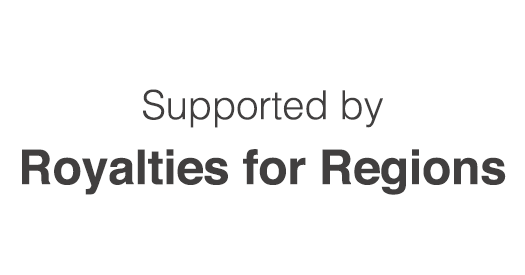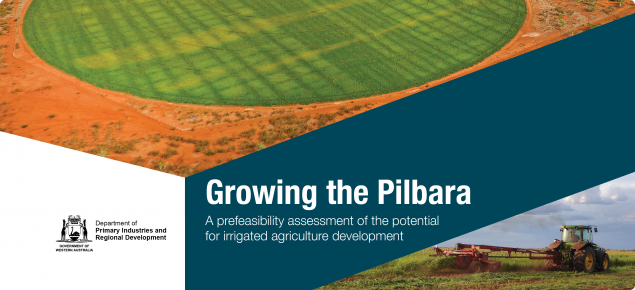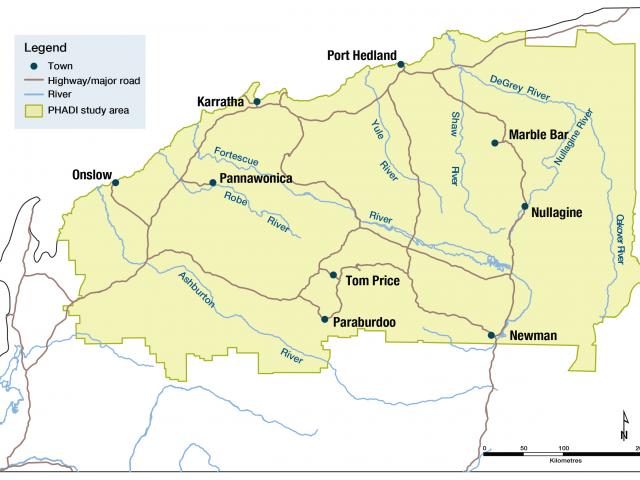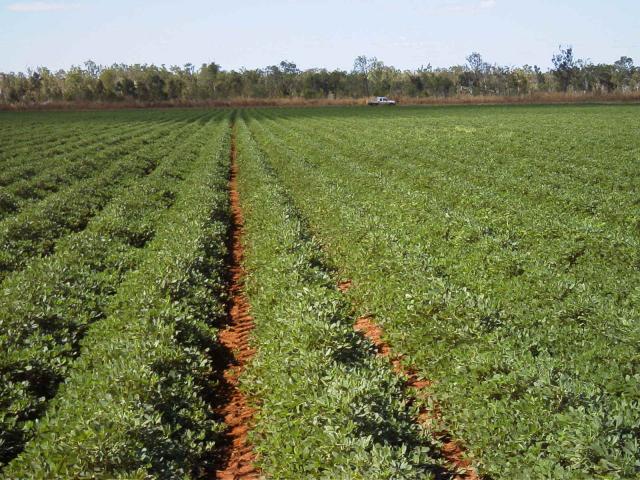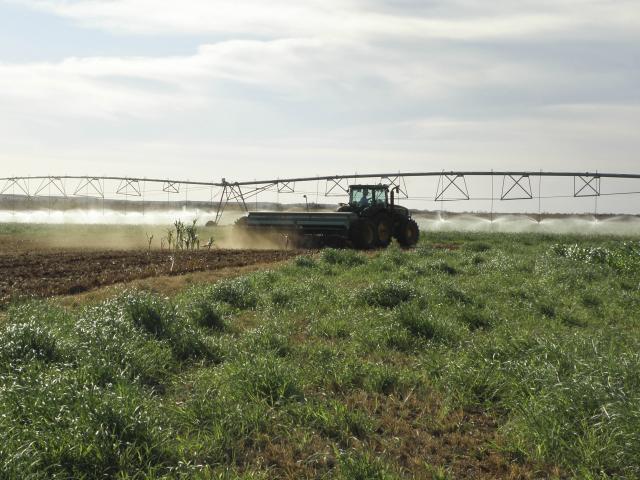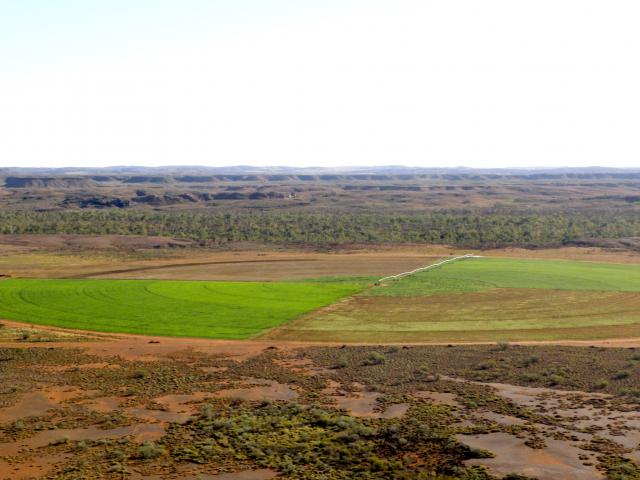Background
In terms of agricultural production, the Pilbara is characterised by its large area and long distance from markets, a very high degree of solar radiation, low average rainfall, a very high incidence of cyclones and associated wet seasons, and highly variable rainfall.
Consequently, extensive pastoralism has been the dominant agricultural industry in this region since European settlement in the late nineteenth century. While there are anecdotes of pastoralists irrigating pasture to provide supplementary fodder to livestock or working animals, this was confined to very small areas with basic infrastructure.
There are currently 2550 hectares under irrigation in the Pilbara at seven irrigation sites.
The first large scale irrigation development in the Pilbara was at Minderoo Station in the late 2000s. Other pastoral companies have since commissioned irrigation sites on Pardoo and Wallal Downs Stations. Warrawagine Station commissioned irrigators adjacent to the Woodie Woodie pilot site developed by the PHADI project. Rio Tinto developed Hamersley and Nammuldi agricultural projects on Hamersley Station to manage mine dewater surplus.
To date, irrigation activities in the Pilbara have focused on production of fodder for pastoral enterprises.
Transforming Agriculture in the Pilbara (TAP) project
The Transforming Agriculture in the Pilbara (TAP) project is ground-proofing soil and water resources in the region for potential horticulture, fodder and field crop production for a range of irrigation development sizes.
Ten areas with significant land and water resources have been identified and some have become the focus of further soil and water field validation, including the lower De Grey River, Shaw River, Karratha Hinterland and Newman.
The TAP project is working with industry partners on several irrigated systems research topics to optimise productivity from suitable land and water resources.
Pilbara land and water resource assessment
Field survey, sampling and analysis work will identify land and water resources suitable for irrigation development. This work is underway at several target locations in the Robe River, Karratha Hinterland, Lower DeGrey, Shaw River and Newman areas.
Activities include:
- census of pastoral and production bores to map groundwater depth and quality
- exploratory drilling for water
- aquifer pumping tests to determine sustainable yields
- sharing water resource information with Department of Water and Environmental Regulation to assist their planning and licencing processes
- surveys to map out suitable soils and identify potential irrigation risks
- identification of Aboriginal heritage and environmental sensitivities in potential development areas.
Economic analysis and business development
As soil and water information become available, TAP is appraising the economic potential of target investigation sites by exploring a range of development scenarios with current tenure holders and potential investors.
Activities include:
- evaluating the best strategies to use irrigation to drive productivity and profitability in beef production.
- analysing to optimise infrastructure requirements needed to develop irrigation water resources at various sites.
- calculating the viability of forage, grain, fibre and horticultural crop opportunities in the Pilbara
- compiling and reporting of land, water and economic information for specific development areas.
- providing a point of contact to access information on soil and water, economics and regulatory requirements specific to individual client enquiries.
Irrigated agriculture research
TAP supports existing irrigators and is evaluating new opportunities by working with industry, CSIRO and relevant collaborators to answer research questions.
Activities include:
- a horticultural ‘proof of concept’ site at Newman that will evaluate potential production of high value temperate fruit crops in this unique inland, elevated Pilbara location.
- modelling and field evaluation of a range of field crop grain, forage and fibre species in the Pilbara environment.
Pilbara Hinterland Agricultural Development Initiative
The Pilbara Hinterland Agricultural Development Initiative (PHADI) (2014-2017) was the first comprehensive investigation into irrigated agriculture opportunities in the region and the findings are now available in a series of reports and factsheets to help government, investors, pastoralists and industry gain insight into its potential.
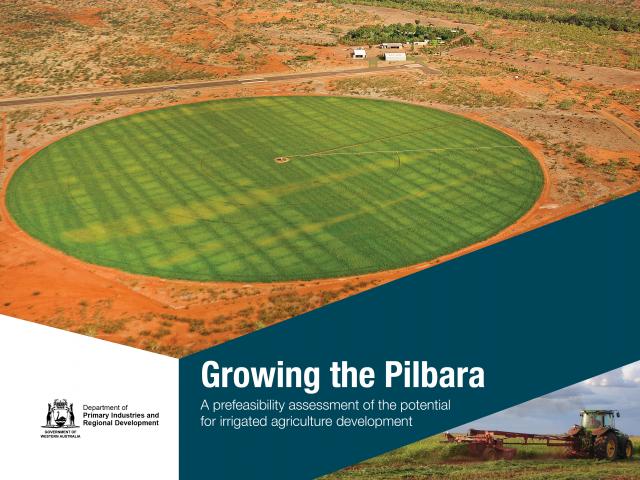
Growing the Pilbara report
Growing the Pilbara summarises the major findings from the PHADI project and delivers a prefeasibility assessment of the irrigation development opportunities in the Pilbara.
The report outlines the opportunity for development of medium-to-large scale irrigation enterprises in the region. It follows a methodology for assessing resource options, identifying markets, and evaluating the regulatory framework for irrigation in the Pilbara.
While intended as a guide for government and private investors, this report highlights where DPIRD believes suitable soil and water resources exist in the Pilbara, identifies potential markets, and investigates the viability of some systems and development opportunities. It attempts to show where and how irrigated agriculture could develop in the Pilbara. Further work will be required to consolidate the findings before investment proceeds.
Other studies on resources for irrigation in the Pilbara
Pilbara Irrigated Agriculture Feasibility Study
The Pilbara Irrigated Agriculture Feasibility Study (PIAFS), led by Jacobs Group (Australia) and the Minderoo Group, was aimed at delivering investor-ready irrigation projects based on an economic mosaic model, rather than the traditional capital intensive (and potentially uneconomic) larger scale approach.
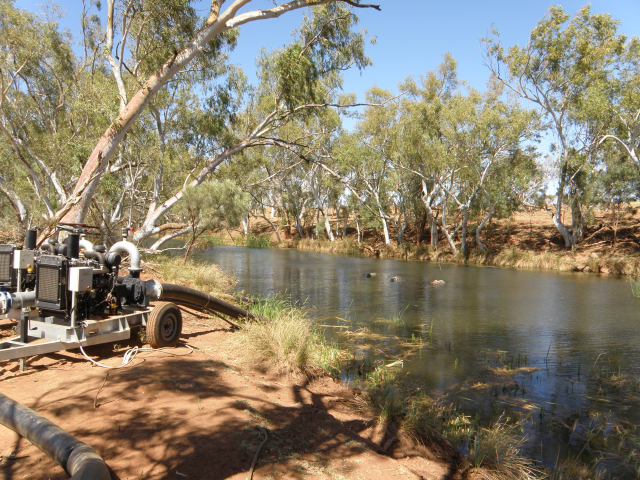
DPIRD supported this project with information from the Pilbara Hinterland Agricultural Development Initiative and assistance with field assessments of land and water resources. The study consisted of three phases. Reports for Phase 1, 2 and 3 are large electronic files and available from the DPIRD upon request.
This study is supported by funding from the Australian Government National Water Infrastructure Development Fund, an initiative of the Northern Australia and Agricultural Competitiveness White Paper.
Oakover Valley Study
The GHD Oakover Valley Study report, also support by the National Water Infrastructure Development Fund, explored irrigation development options on the Oakover River, on Warrawagine Station.
Economic studies on Pilbara irrigation
Market opportunities for northern WA fruit and vegetable production
DPIRD is working to highlight the irrigation development opportunities in the Pilbara region. Currently, this region of WA has no commercial horticultural enterprises. Whilst the Pilbara is known for its harsh summer weather, winter in the north is favourable for the production of many horticultural crops.
Whilst many horticultural crops species could be successfully cultivated in the Pilbara during the milder months, there is little valuing in producing for markets that are already well supplied. Information about market opportunity is paramount when making investment decisions.
With this end in view, market opportunities for fruits and vegetables with perceived production potential in the Pilbara were analysed. This study explored opportunities in export markets; the possibility of replacing product imported to Australia (including WA); and opportunities for replacing the supply from the Eastern States entering the WA domestic market.) Detailed findings of this analysis is presented in a series of short reports. Each report covers one product line and discusses the opportunities in each of the three market settings.
Market opportunities for peaches and nectarines
Economic analysis of irrigated agriculture development options for the Pilbara
DPIRD engaged GHD to undertake a preliminary economic analysis of options for developing irrigated agriculture in the Pilbara, Western Australia. The Economic Analysis of Irrigated Agriculture Development Options for the Pilbara report provides businesses, industry and potential investors with a preliminary economic assessment of a range of irrigated crops in the Pilbara including those grown for fodder, industrial use, biofuel feedstock, fibre, food and processing.
The report includes:
- a summary and background of pertinent information currently available on the economic viability of some irrigated agriculture in the Pilbara
- market analysis of crops, including existence or otherwise of supply chains to market (domestic and export)
- economic analysis of selected crops including gross margins, net present value and sensitivities
- risk assessment and development of potential scenarios, which combine different crop rotations, processing and marketing options.
Growing the North - market opportunities for irrigated agricultural produce from northern Western Australia
Growing demand for safe, high quality food in Asia and the Middle East is creating a unique opportunity for the agricultural sector in the north. DPIRD commissioned Growing the North – a report into market opportunities for irrigated agricultural produce from Northern Western Australia to identify high-potential products, at the intersection of what markets are demanding and what the north can produce.

Growing the North takes a market-led approach to understand what products our key target markets want, and what can be competitively produced in the north of Western Australia.
DPIRD commissioned the Growing the North report to identify potential products which might suit northern production conditions and export market demands.
Check out the full report and summary flyer on the Growing the North page.
Pilbara irrigation research studies
Woodie Woodie pilot research site technical report
The Woodie Woodie Pilot Project originated as a feasibility and research project for the establishment of irrigated agriculture utilising mine dewater in the semi-arid Pilbara. The pilot site was established on Warrawagine Station during 2014 and ran through until 2016. Water from the site was captured from the stream flow of mine dewater surplus discharged from the nearby Woodie Woodie mine.
The site was used to appraise a number for crop and forage species. The experimental irrigation site was challenged with the irregular water supply associated with mining activity, highlighting the risk of using a sole MDS supply. This issue flagged the need to factor in an ability to buffer MDS supplies with above or below ground storage, a backup source or multiple MDS sources to mitigate the risk of a low water supply event.
Technical reports on the development approvals and costs and field crop research findings are available upon request.

